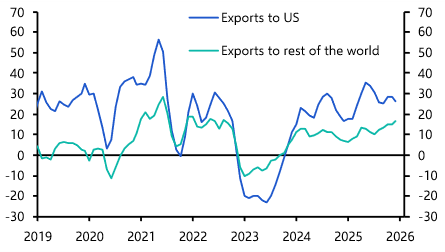We have published several pieces over the past week that shed some light on the thorny question of whether a bubble has inflated in asset markets. You can read the detail here, but several points emerge that are worth reflecting upon.
The first is that evidence of speculative excess in some markets does not imply that there’s a bubble in risky assets more generally. The surge in the price of Bitcoin has captured the headlines and bears all the hallmarks of a bubble. But it’s worth remembering that the cryptocurrency has been through a boom-bust cycle before in 2016-18 without having wider implications for other asset markets. Bitcoin remains a tiny part of most portfolios and should not be regarded as a barometer of general investor sentiment or asset valuations. Indeed, despite euphoria in some pockets of the market, the price of some risky assets, including equities in the UK and Europe, remain below their pre-pandemic levels.
The second point to note is that systemic asset price bubbles (i.e. those affecting more than just a handful of securities) have typically had several characteristics that are not present today. Leverage has played an important role in inflating previous asset price bubbles but is not especially high by past standards. Likewise, financial imbalances do not look extreme. The situation today therefore looks different from previous episodes of “irrational exuberance”.
This brings us to the third, and most important, point, which is that against the backdrop of negative real interest rates, recent moves in risky asset prices actually look rational. As we’ve noted before, the sustainable level of risk-free real interest rates is lower now than in the past, meaning that the sustainable valuations of risky assets should be higher. Bitcoin aside, much of the focus has been on the US equity market. On a cyclically-adjusted price-earnings basis, the S&P 500 is now trading on a higher multiple than in the run-up to the 1929 crash and close to the peak of the dotcom bubble. (See Chart 1.)
Chart 1: Shiller’s Cyclically-Adjusted Price-Earnings Ratio for S&P 500
 Source: Shiller
Source: Shiller However, the picture looks very different if we view the valuation of equities in the context of today’s very low level of bond yields. This can be done by comparing the earnings yield of the stock market, which is the inverse of the price/earnings ratio, to real bond yields. Previous collapses in the US stock market, for example in 1929 and in 2000, when the dot-com bubble burst, have been preceded by a period in which stock prices have been bid up to the point where the earnings yield has fallen below the real yield on 10-year US Treasuries. But today, the earnings yield of the S&P 500 is still some way above real 10-year yields. (See Chart 2.) In other words, the current valuation of US equities can be justified in the context of negative real interest rates.
Chart 2: Relative Valuations of US Equities & Treasuries
 Sources: Refinitiv, Shiller
Sources: Refinitiv, ShillerViewed this way, the real question is not so much whether there is a systemic bubble in risky assets, but whether real rates remain at their current ultra-low levels. Our forecast is that they will, which is why we don’t anticipate a collapse in the price of risky assets – indeed, we think a combination of economic recovery and continued policy accommodation will drive the price of most risky assets higher over the course of this year.
The obvious risk to this view is that we’re wrong and real interest rates do rise – although even if this were to happen the underlying reasons for the rise would have important implications for asset prices. If it resulted from a stronger economic expansion, the drag on equities would presumably be smaller than if it were due to the Fed rowing back on its new flexible average inflation targeting framework. Another key risk is that our relatively upbeat economic forecasts prove to be wrong and the global economy takes another leg down. As I noted last week, the biggest threat on this front stems from unanticipated developments in either the virus or the rollout and efficacy of vaccines.
Most importantly, none of this means that a bubble in risky assets won’t inflate over the coming years. Aside from during the decades of very stringent financial regulation and capital controls just after the Second World War, systemic bubbles have been a recurring feature of capitalist economies. With monetary policy set to remain loose for some time, history suggests it would be unwise to bet against another inflating over the next few years. As things stand, however, the balance of evidence suggests that most assets are not yet in bubble territory.
In case you missed it:
- Our Senior China Economist, Julian Evans-Pritchard, explains why there’s likely to be more work and less travel during the upcoming Lunar New Year holiday.
- Our Senior Europe Economist, Jack Allen-Reynolds, takes stock of the rise in household savings in the euro-zone and assesses the implications for consumer spending this year.
- Our Senior US Economist, Andrew Hunter, argues that any fiscal package that is eventually passed by Congress may be less than half the size of the one unveiled by proposed by President-elect Biden last week.




